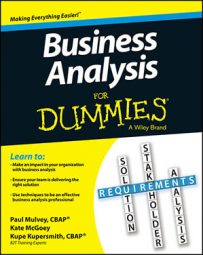Even though observation methods for business analysis are pretty simple, there are three different approaches you can use for observing a business user in action:
Pure observation without interaction: In this model, you simply show up, remain quiet, and watch the person work.
Observation with interaction: Here, you do get to interact with the person who performs the job. He can talk to you and you to him as he goes about performing the process you’re observing. This method is a great way to not only ask questions that lead to understanding the process but also to establish rapport with your stakeholders.
Performing the task yourself: This method is where you get to perform the job yourself a la the television program Dirty Jobs. With this approach, you establish even more credibility than when you observe with interaction; as an added benefit, you often stumble upon answers to unanswered questions.
Observation can not only be used to find out how things work, but it can also be used to confirm other forms of elicitation. By observing, you can see for yourself just how the process is performed in real life. Because this technique can provide so much information, you should strive to integrate different observation techniques into your elicitation to thoroughly capture your information.
Ready to get started with observation? Here’s how you do it:
Figure out when you want to observe.
Find out from your stakeholders when the best time to observe this process is. Does the process happen only at a certain time each day? Are there peak times to watch the process? If, for instance, you’re observing the process of traffic management around Los Angeles, watching during rush hour shows you a much different experience than observing Saturday at 3:30 a.m.
Get permission to observe.
Seek permission from the management team before you set up and start watching people. Showing up unannounced can make those you’re observing uncomfortable.
Try to put the folks you’re observing at ease. Let them know you aren’t there as a threat but rather to understand their jobs so you can make it easier for them (or whatever the actual reason is). Make sure they know that you want to hear any suggestions they have about the process you’re studying that will make their jobs easier.
Observe (or better yet, do the job yourself) and make notes.
Pay attention to these things:
Process: Note the entire sequence of events that occur, in order, being sure to include quantifiable information (such as how many widgets get pulled from the assembly line because of defects during the given time period or how often the line has to be stopped or slowed because of a glitch).
Business rules: What rules are highlighted during observation. Sticking with the assembly-line example, the business rule would specify how a defect is defined.
External agents: The external agents are the people performing the work. Note who is responsible for each part of the process.
Data: The data is the information used during the process. What information is needed to perform the process, and what data is updated as a result of the process?
After the observation period, use the notes you took in Step 3 to record all your observations.
These observations will lead to your understanding of the process and to additional questions surrounding the process. Also keep in mind that something that may seem insignificant in the process (like wearing gloves when sorting packages) can actually turn out to be pretty important.
When observing others, you need to realize that people will try hard to not make mistakes or will tend to follow the process as defined — behavior that doesn’t always reflect reality. Suggest to the person you are observing to act as though you are not there.

